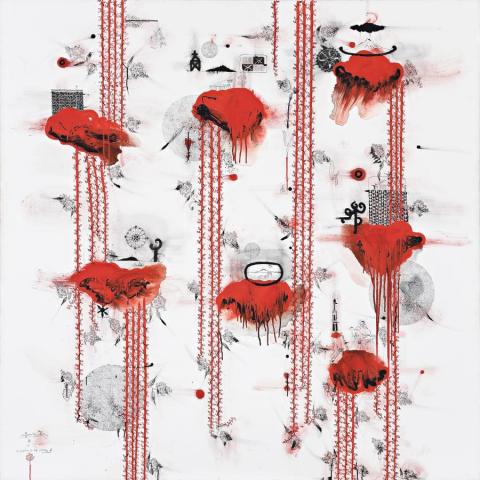IN PREPARATION FOR THAT PROMISE, 2007
JOHN PULE
oil, ink and enamel on canvas
200.0 x 200.0 cm
signed, dated and titled lower left: John Puhiatau Pule / 2007 / In preparation for that promise
Karen Woodbury Gallery, Melbourne
Private collection, Melbourne
John Pule: Amanakiaga, Karen Woodbury Gallery, Melbourne, 10 October – 3 November 2007 (label attached verso)
Woodbury, K. (ed.), John Pule – Amanakiaga, Karen Woodbury Gallery, Melbourne, 2007, p. 11 (illus.)
'As pointed and political as his art might be, John Pule invites us to understand him through his distinctive view of the interconnections between places and their history - the body and spirit - cosmology too. These are places of mystery and contemplation, and where we are never frog-marched to enlightenment.'1
There is no one simple pathway into a John Pule painting, or one convenient explanation for his interwoven iconography. Instead he coaxes the viewer to come closer, to meander through the passages of his work, bringing us to the point where unwittingly we are all at once confronted with the tragedy, beauty and temporality of our own humanity. These works are not of any particular time or place, nor are they fixed in history. Instead Pule reminds us that we are simply a distant punctuation mark in the narrative and continuum of life, mythology and endlessness. Certainly, these paintings spring from strong traditional stock, grounded in Niuean mythology and art practice. Much has been said of the influence in Pule's work of the hiapo bark cloth tradition and the evolution of that craft in the presence of the missionaries despatched to Niue in the 19th century. Earlier works may have payed homage to this tradition in their grid-like structures but in these later canvases images of hiapo cloth simply float through his paintings alongside space ships, vignettes of the deposition of Christ, processional marches and animal heads.
Pule returns to Christian motifs regularly and emerging behind the blood stains and peony roses we often find the Pietà, the most intimate Christian symbol concerned with loss, suffering, anguish, grief and ultimately the precursor to redemption and renewal. In In Preparation for that Promise this symbol appears almost as a stencil reminding us of its repetition and diminishing it, as though it is only but one of so many instances in history of profound loss and injustice. Colonisation, migration, in fact all conflicts bring forth their own grieving and blood letting. Indeed the most obvious element in this series of works by Pule is the dense blood red clouds dripping and seeping through the white canvas. A constant in his work, these 'clouds' are rich in metaphor. Some have interpreted them as islands or pools, not clouds at all. While overtones of violence and death are accentuated, a sense of fecundity and growth is also present. As always in Pule's work the clouds and the events unfolding below them are linked and entwined by the trailing ti mata alea or Cordyline vines and flowers and sometimes peony roses. According to Niuean mythology the first people of Nieu originated from the Cordyline tree so in some respects these paintings are part of the larger creation mythologies of the Pacific and beyond.
In Preparation of that Promise was painted for John Pule's first Melbourne exhibition in 2007 and it closely relates to Mamalu (When I look at the world) exhibited at Karen Woodbury Gallery and acquired by the National Gallery of Victoria.
1. Hall, D, in Woodbury, K. (ed.), John Pule - Amanakiaga, Karen Woodbury Gallery, Melbourne, 2007, p. 8
LARA NICHOLLS
